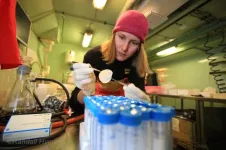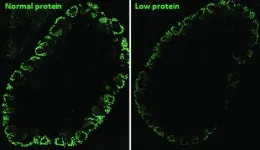Meet the freaky fanged frog from the Philippines
2021-05-05
(Press-News.org) LAWRENCE -- Researchers at the University of Kansas have described a new species of fanged frog discovered in the Philippines that's nearly indistinguishable from a species on a neighboring island except for its unique mating call and key differences in its genome.
The KU-led team has just published its findings in the peer-reviewed journal Ichthyology & Herpetology.
"This is what we call a cryptic species because it was hiding in plain sight in front of biologists, for many, many years," said lead author Mark Herr, a doctoral student at the KU Biodiversity Institute and Natural History Museum and Department of Ecology & Evolutionary Biology. "Scientists for the last 100 years thought that these frogs were just the same species as frogs on a different island in the Philippines because they couldn't tell them apart physically. We ran a bunch of analyses -- and they do indeed look identical to the naked eye -- however, they are genetically isolated. We also found differences in their mating calls. They sound quite different. So, it was a case of using acoustics to determine that the species was different, as well as the new genetic information."
Genetic samples of the new frog, known scientifically as Limnonectes beloncioi (or commonly as the Mindoro Fanged Frog), were collected years ago by KU scientists working in the field on Mindoro Island in the central Philippines but weren't analyzed until recently. Because of its nearly identical physical similarity to a fanged frog on the island of Palawan, called Acanth's Fanged Frog, it was assumed to be the same species.
"You can look at two different things, but to the human eye without intensive investigation they might seem the same," Herr said. "So, we took a bunch of measurements of hundreds of these frogs -- how long their digits were specifically, how wide the tip of their toe was, the length of one specific segment of their leg, the diameter of their eye -- in order to compare populations statistically, even if we thought they look the same. We ran statistical analyses on body shape and size, including a principal component analysis which uses all the measurements at once to compare the frog morphology in multivariate space. After all that, just like the scientists before us, we found nothing to differentiate the frogs based on the shape of their bodies and their size."
However, because the fanged frogs inhabit islands separated by miles and miles of ocean, the researchers had doubts they were the same species, in part because they had different-sounding calls. They decided to analyze the frogs' genome and determined the Mindoro Fanged Frog qualified as its own distinct species.
"We ran genetic analyses of these frogs using some specific genetic markers, and we used a molecular clock model just to get a very basic estimate how long we thought that these frogs may have been separated from one another," Herr said. "We found they're related to each other, they are each other's close relatives, but we found they'd been separate for two to six million years -- it's a really long time for these frogs. And it's very interesting that they still look so similar but sound different."
The KU graduate student specializes in studying the many species of fanged frog across Southeast Asia, where he's carried out extensive fieldwork. He said the frogs' fangs likely are used in combat for access to prime mating sites and to protect themselves from predators. The Mindoro Fanged Frog, a stream frog, is sometimes hunted by people for food.
But the frog's characteristic call, different from Acanth's Fanged Frog, proved difficult for researchers to record.
"They're really wary of us when we're out there with our sound recorders trying to get recordings of these frogs -- that's a really tough aspect, and we were lucky in this project that we had people over many years that were out there and had recorded both of these frogs on Palawan and Mindoro. So, we had recordings from both islands, and that's kind of rare with this group of fanged frogs because people eat them. They call at night, but the second a flashlight or human voice wanders into the equation they're just going to take off -- because they know that they can be killed by people."
Herr's description of the Mindoro Fanged Frog continues a long tradition of KU field research into the herpetological biodiversity of the Philippines and Southeast Asia, according to his faculty adviser Rafe Brown, professor of ecology & evolutionary biology and curator-in-charge of the Herpetology Division of the Biodiversity Institute and Natural History Museum.
"Mark's discovery reinforces a lesson we've learned over and over through the years -- things we thought we knew, combined with new information, emerge to teach us something completely unexpected," Brown said. "A century ago, KU professor Edward Taylor identified the Mindoro Island population as Acanth's Fanged Frog, the same species as he had named, a few years before, from Palawan Island -- an arrangement that made very little sense. Zoom forward a hundred years, and we find with new technology, genetic information and bioacoustic data that the two islands' populations are actually very well-differentiated, as we would expect. But not morphologically; their physical characteristics have not diverged. This is a case in which the formation of species has not been accompanied by morphological differentiation -- so called 'cryptic speciation.'"
INFORMATION:
Herr's co-authors on the new paper are Brown; KU graduate students Johana Goyes Vallejos and Robin Abraham; Camila Meneses of the University of the Philippines at Los Baños; Rayanna Otterholt of Haskell Indian Nations University; Cameron Siler of the University of Oklahoma; and Edmund Leo B. Rico of the Center for Conservation Innovations and College of Sciences De La Salle University-Dasmariñas, Philippines.
[Attachments] See images for this press release:

ELSE PRESS RELEASES FROM THIS DATE:
2021-05-05
"The findings of our study tell us where and when greenhouse gas is being most absorbed in Arctic waters." Says Friederike Gründger, who conducted the study as part of her post-doctoral research at CAGE.
The study, which was conducted on the shallow shelf west of Svalbard, took a closer look at communities of bacteria that use methane as an energy source and carbon substrate for growth. The results from the study show that these methane-oxidizing bacteria are highly affected by the specific underwater landscape and seasonal conditions in the study area.
"Several large depressions, up to 40m deep, are observed along the shallow shelf off Western Svalbard, ...
2021-05-05
In 2005, greenhouse gas (GHG) emissions from residential energy use hit an all-time high in the United States. Each year since, emissions have dropped at an average annual rate of 2 percent.
In a study published in Environmental Research Letters, "Drivers of change in US residential energy consumption and greenhouse gas emissions, 1990-2015," a team of researchers from the Yale School of the Environment (YSE) outlined several factors that have contributed to this decrease, highlighting efficiencies in new home construction, energy consumption and household appliances, ...
2021-05-05
(Philadelphia, PA) - For patients with chronic pain, ineffective treatments, lowered work productivity, and other factors often coalesce, fueling feelings of hopelessness and anxiety and setting the stage for even bigger problems, including substance use disorders. In 2017 alone, some 18 million Americans misused prescription pain relievers over the course of the previous year. In many of these instances, patients suffering from chronic pain became addicted to prescription opioids.
In addition to being highly addictive, many studies suggest that prescription opioids do not effectively control pain over the long term, and hence researchers ...
2021-05-05
Many people with diabetes endure multiple, painful finger pricks each day to measure their blood glucose. Now, researchers reporting in ACS Sensors have developed a device that can measure glucose in sweat with the touch of a fingertip, and then a personalized algorithm provides an accurate estimate of blood glucose levels.
According to the American Diabetes Association, more than 34 million children and adults in the U.S. have diabetes. Although self-monitoring of blood glucose is a critical part of diabetes management, the pain and inconvenience caused ...
2021-05-05
At the beginning of the COVID-19 pandemic, intense social distancing and lockdown measures were the primary weapon in the fight against the spread of SARS-CoV-2, but they came with a monumental societal burden. New research from the Center for the Ecology of Infectious Diseases and the College of Public Health at the University of Georgia explores if there could have been a better way.
Published in the journal Proceedings of the Royal Society B, the research analyzes more palatable alternatives to the kind of social distancing mandates that threw a wrench at how businesses, schools ...
2021-05-05
A study published in July 2020 hypothesized a link between the presence of bradykinin, a well-known peptide, and severe cases of COVID-19. Vardan Karamyan, Ph.D., an associate professor and vice chair for the Texas Tech University Health Sciences Center (TTUHSC) Jerry H. Hodge School of Pharmacy Department of Pharmaceutical Sciences, had not previously conducted or evaluated any research related to COVID-19. However, he found the article intriguing because it discussed bradykinin, one of three specific peptides with which his lab has much well-published experience.
The paper received a lot of attention in both the media and scientific literature, but as Karamyan read through it, he felt it failed to address an equally important part of a bigger picture: the likely ...
2021-05-05
A new service piloted at Penn Medicine allowed a proportion of patients to avoid hospitalization by providing them with greater support after visiting the emergency department. The vast majority of the patients enrolled in the service - nearly 9 out of 10 - did not need to return to the hospital for care in the month that followed their initial visit. The study was published in Healthcare.
"The culture is shifting where we realize that hospitalization is not always the best option for patients - particularly patients with chronic illness," said one of the study's lead authors, Austin Kilaru, MD, an emergency physician at Penn Medicine. "We need to find better ways of helping patients not just get healthy in a hospital, but stay healthy at ...
2021-05-05
Leather is an ever growing multi-billion dollar industry requiring more than 3.8 billion bovine animals - equal to one for every two people on earth - to sustain production each year. And while the products - clothing, shoes, furniture and more - can be quite elegant and durable, the environmental impact of leather production has been severe, leading to deforestation, water and land overuse, environmental pollution, and greenhouse gas emissions.
Researchers at Tufts University School of Engineering set out to find an alternative to leather, with similar texture, flexibility and stiffness, yet focused on materials that are sustainable, non-toxic, and friendly to the environment. It turns out, we have been wearing that material ...
2021-05-05
PITTSBURGH, May 5, 2021 - Subtle differences in the shape of the brain that are present in adolescence are associated with the development of psychosis, according to an international team led by neuroscientists at the University of Pittsburgh School of Medicine and Maastricht University in the Netherlands.
In results published today in JAMA Psychiatry, the differences are too subtle to detect in an individual or use for diagnostic purposes. But the findings could contribute to ongoing efforts to develop a cumulative risk score for psychosis that would allow for earlier detection and treatment, as well as targeted therapies. The discovery was made with the largest-ever ...
2021-05-05
Besides being underweight, babies born to women whose diet lacked sufficient protein during pregnancy tend to have kidney problems resulting from alterations that occurred while their organs were forming during the embryonic stage of their development.
In a study published in PLOS ONE, researchers affiliated with the University of Campinas (UNICAMP) in the state of São Paulo, Brazil, discovered the cause of the problem at the molecular level and its link to epigenetic phenomena (changes in gene expression due to environmental factors such as stress, exposure to toxins or malnutrition, among others).
According to the authors, between 10% and 13% of the world population ...
LAST 30 PRESS RELEASES:
[Press-News.org] Meet the freaky fanged frog from the Philippines






